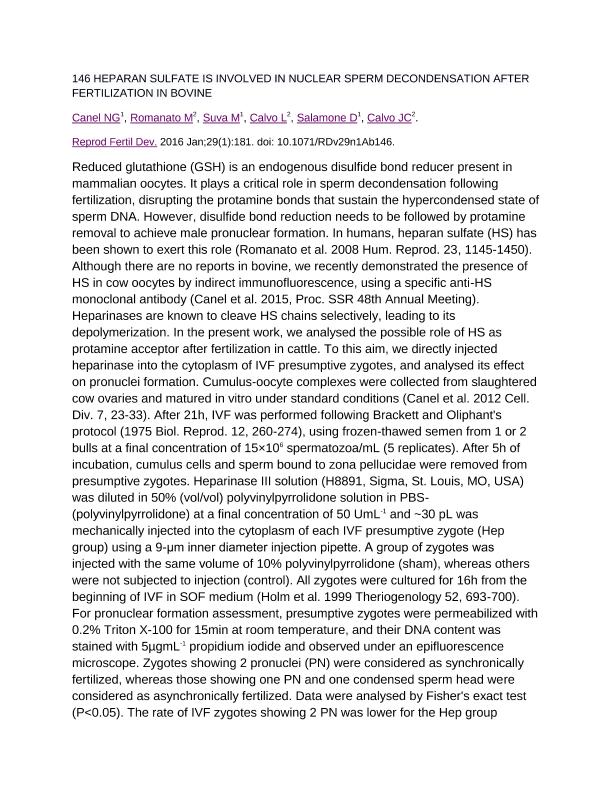Mostrar el registro sencillo del ítem
dc.contributor.author
Canel, Natalia Gabriela

dc.contributor.author
Romanato, Marina

dc.contributor.author
Suvá, Mariana

dc.contributor.author
Calvo, L.
dc.contributor.author
Salamone, Daniel Felipe

dc.contributor.author
Calvo, Juan Carlos

dc.date.available
2017-06-22T15:31:34Z
dc.date.issued
2016-12-02
dc.identifier.citation
Canel, Natalia Gabriela; Romanato, Marina; Suvá, Mariana; Calvo, L.; Salamone, Daniel Felipe; et al.; 146 Heparan sulfate is involved in nuclear sperm decondensation after fertilization in bovine; Csiro Publishing; Reproduction Fertility And Development; 29; 1; 2-12-2016; 181-181
dc.identifier.issn
1031-3613
dc.identifier.uri
http://hdl.handle.net/11336/18634
dc.description.abstract
Reduced glutathione (GSH) is an endogenous disulfide bond reducer present in mammalian oocytes. It plays a critical role in sperm decondensation following fertilization, disrupting the protamine bonds that sustain the hypercondensed state of sperm DNA. However, disulfide bond reduction needs to be followed by protamine removal to achieve male pronuclear formation. In humans, heparan sulfate (HS) has been shown to exert this role (Romanato et al. 2008 Hum. Reprod. 23, 1145-1450). Although there are no reports in bovine, we recently demonstrated the presence of HS in cow oocytes by indirect immunofluorescence, using a specific anti-HS monoclonal antibody (Canel et al. 2015, Proc. SSR 48th Annual Meeting). Heparinases are known to cleave HS chains selectively, leading to its depolymerization. In the present work, we analysed the possible role of HS as protamine acceptor after fertilization in cattle. To this aim, we directly injected heparinase into the cytoplasm of IVF presumptive zygotes, and analysed its effect on pronuclei formation. Cumulus-oocyte complexes were collected from slaughtered cow ovaries and matured in vitro under standard conditions (Canel et al. 2012 Cell. Div. 7, 23-33). After 21h, IVF was performed following Brackett and Oliphant´s protocol (1975 Biol. Reprod. 12, 260-274), using frozen-thawed semen from 1 or 2 bulls at a final concentration of 15×106 spermatozoa/mL (5 replicates). After 5h of incubation, cumulus cells and sperm bound to zona pellucidae were removed from presumptive zygotes. Heparinase III solution (H8891, Sigma, St. Louis, MO, USA) was diluted in 50% (vol/vol) polyvinylpyrrolidone solution in PBS-(polyvinylpyrrolidone) at a final concentration of 50 UmL-1 and ~30 pL was mechanically injected into the cytoplasm of each IVF presumptive zygote (Hep group) using a 9-μm inner diameter injection pipette. A group of zygotes was injected with the same volume of 10% polyvinylpyrrolidone (sham), whereas others were not subjected to injection (control). All zygotes were cultured for 16h from the beginning of IVF in SOF medium (Holm et al. 1999 Theriogenology 52, 693-700). For pronuclear formation assessment, presumptive zygotes were permeabilized with 0.2% Triton X-100 for 15min at room temperature, and their DNA content was stained with 5µgmL-1 propidium iodide and observed under an epifluorescence microscope. Zygotes showing 2 pronuclei (PN) were considered as synchronically fertilized, whereas those showing one PN and one condensed sperm head were considered as asynchronically fertilized. Data were analysed by Fisher´s exact test (P<0.05). The rate of IVF zygotes showing 2 PN was lower for the Hep group (60.3%, n=131) than those from sham (94.1%, n=119) and control groups (98%, n=101), which did not differ between them (P<0.05). In conclusion, our results show for the first time that HS is involved in bull chromatin sperm decondensation and allow us to propose HS as a putative protamine acceptor during male pronucleus formation after IVF in cattle. Given the high frequency of sperm decondensation failure observed in bovine after intracytoplasmic sperm injection, this work provides new insights for the development of novel sperm/egg treatments that might improve intracytoplasmic sperm injection outcomes in cattle.
dc.format
application/pdf
dc.language.iso
eng
dc.publisher
Csiro Publishing

dc.rights
info:eu-repo/semantics/openAccess
dc.rights.uri
https://creativecommons.org/licenses/by-nc-sa/2.5/ar/
dc.subject
Heparan Sulfate
dc.subject
Fertilization
dc.subject
Decondensation
dc.subject
Bovine
dc.subject.classification
Biología Reproductiva

dc.subject.classification
Ciencias Biológicas

dc.subject.classification
CIENCIAS NATURALES Y EXACTAS

dc.subject.classification
Otras Ingenierías y Tecnologías

dc.subject.classification
Otras Ingenierías y Tecnologías

dc.subject.classification
INGENIERÍAS Y TECNOLOGÍAS

dc.title
146 Heparan sulfate is involved in nuclear sperm decondensation after fertilization in bovine
dc.type
info:eu-repo/semantics/article
dc.type
info:ar-repo/semantics/artículo
dc.type
info:eu-repo/semantics/publishedVersion
dc.date.updated
2017-06-21T16:50:17Z
dc.identifier.eissn
1448-5990
dc.journal.volume
29
dc.journal.number
1
dc.journal.pagination
181-181
dc.journal.pais
Australia

dc.description.fil
Fil: Canel, Natalia Gabriela. Consejo Nacional de Investigaciones Científicas y Técnicas. Oficina de Coordinación Administrativa Pque. Centenario. Unidad Ejecutora de Investigaciones En Producción Animal. Universidad de Buenos Aires. Facultad de Ciencias Veterinarias. Unidad Ejecutora de Investigaciones En Producción Animal; Argentina
dc.description.fil
Fil: Romanato, Marina. Consejo Nacional de Investigaciones Científicas y Técnicas. Instituto de Biología y Medicina Experimental. Fundación de Instituto de Biología y Medicina Experimental. Instituto de Biología y Medicina Experimental; Argentina
dc.description.fil
Fil: Suvá, Mariana. Consejo Nacional de Investigaciones Científicas y Técnicas. Oficina de Coordinación Administrativa Pque. Centenario. Unidad Ejecutora de Investigaciones En Producción Animal. Universidad de Buenos Aires. Facultad de Ciencias Veterinarias. Unidad Ejecutora de Investigaciones En Producción Animal; Argentina
dc.description.fil
Fil: Calvo, L.. Consejo Nacional de Investigaciones Científicas y Técnicas. Instituto de Biología y Medicina Experimental. Fundación de Instituto de Biología y Medicina Experimental. Instituto de Biología y Medicina Experimental; Argentina
dc.description.fil
Fil: Salamone, Daniel Felipe. Consejo Nacional de Investigaciones Científicas y Técnicas. Oficina de Coordinación Administrativa Pque. Centenario. Unidad Ejecutora de Investigaciones En Producción Animal. Universidad de Buenos Aires. Facultad de Ciencias Veterinarias. Unidad Ejecutora de Investigaciones En Producción Animal; Argentina
dc.description.fil
Fil: Calvo, Juan Carlos. Consejo Nacional de Investigaciones Científicas y Técnicas. Instituto de Biología y Medicina Experimental. Fundación de Instituto de Biología y Medicina Experimental. Instituto de Biología y Medicina Experimental; Argentina
dc.journal.title
Reproduction Fertility And Development

dc.relation.alternativeid
info:eu-repo/semantics/altIdentifier/url/http://www.publish.csiro.au/?paper=RDv29n1Ab146
dc.relation.alternativeid
info:eu-repo/semantics/altIdentifier/doi/http://dx.doi.org/10.1071/RDv29n1Ab146
Archivos asociados
